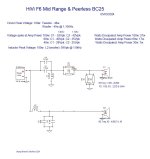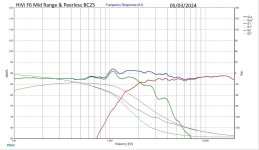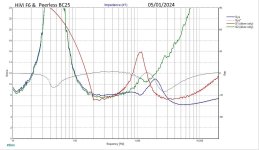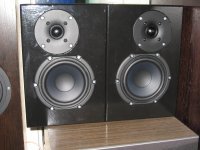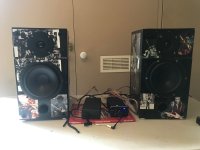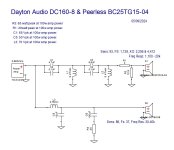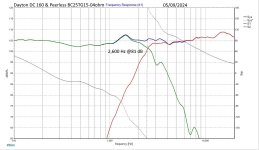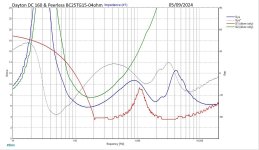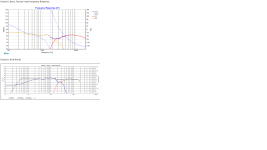Hello DIY Community:
I am attempting to re-build a set of Cerwin-Vega! L7 Bookshelf speakers.
I am a novice speaker builder who does have a couple successful builds under his belt. What I am attempting to do in this post is get some crossover design feedback. I have decided to replace the baffle on these CV-L7’s to accommodate new drivers. These are 2-way speakers.
I have done considerable research on drivers to use and have played around with Xsim to design crossover networks.
IMPORTANT NOTE The data I have been using is either the files from Parts Express, or derived data from manufacturer data sheets. I realize that this data represents ideal conditions at the manufacturer’s facilities. But, since I do not have test software or mics, I want to practice using this as if it was my measure data to get a sense of how to blend the drivers. *
Speake cabinets: ½” particle or MDF with INTERNAL dimensions of : 13” H x 8” W x 7 ¾” D.
Estimated volume is 0.47ft^3 (13.21 liters).
The port can be customized to the needed length. My current calculation (WinISD) is: Tuning Frequency 50.93Hz with one 1.67” x 3.6” vent. (This uses the existing port and tube, just shortened from 5”).
I have decided to use the following drivers:
HiVi F6 6-1/2" Bass/Midrange
Sensitivity: 88dB 2.83V/1m
Frequency Response: 42 to 4,000Hz
45-90 watt, 8 ohm
Peerless (Tymphany) BC25TG15-08 1" Fabric Dome Tweeter
Sensitivity: 91.71dB 2.83V/1m
Frequency response: 1.1kHz – 20kHz
100-watt, 8 ohm.
Frequency Response: 1,000 to 20,000Hz
I am posting the XO network I designed and a couple of the graphs.
I would really appreciate your feedback and suggestions on how to improve or to learn what errors I made.
I did try this with 3 different tweeters and 5 different drivers. This particular combo gave me the best graph with the simplest XO and lowest part count - thus the cheapest option. Other combinations produced better looking graphs, but the XO network and part count put the project into the $350 to $800 range! I am budgeting about $300 for components (including drivers).
I am attempting to re-build a set of Cerwin-Vega! L7 Bookshelf speakers.
I am a novice speaker builder who does have a couple successful builds under his belt. What I am attempting to do in this post is get some crossover design feedback. I have decided to replace the baffle on these CV-L7’s to accommodate new drivers. These are 2-way speakers.
I have done considerable research on drivers to use and have played around with Xsim to design crossover networks.
IMPORTANT NOTE The data I have been using is either the files from Parts Express, or derived data from manufacturer data sheets. I realize that this data represents ideal conditions at the manufacturer’s facilities. But, since I do not have test software or mics, I want to practice using this as if it was my measure data to get a sense of how to blend the drivers. *
Speake cabinets: ½” particle or MDF with INTERNAL dimensions of : 13” H x 8” W x 7 ¾” D.
Estimated volume is 0.47ft^3 (13.21 liters).
The port can be customized to the needed length. My current calculation (WinISD) is: Tuning Frequency 50.93Hz with one 1.67” x 3.6” vent. (This uses the existing port and tube, just shortened from 5”).
I have decided to use the following drivers:
HiVi F6 6-1/2" Bass/Midrange
Sensitivity: 88dB 2.83V/1m
Frequency Response: 42 to 4,000Hz
45-90 watt, 8 ohm
Peerless (Tymphany) BC25TG15-08 1" Fabric Dome Tweeter
Sensitivity: 91.71dB 2.83V/1m
Frequency response: 1.1kHz – 20kHz
100-watt, 8 ohm.
Frequency Response: 1,000 to 20,000Hz
I am posting the XO network I designed and a couple of the graphs.
I would really appreciate your feedback and suggestions on how to improve or to learn what errors I made.
I did try this with 3 different tweeters and 5 different drivers. This particular combo gave me the best graph with the simplest XO and lowest part count - thus the cheapest option. Other combinations produced better looking graphs, but the XO network and part count put the project into the $350 to $800 range! I am budgeting about $300 for components (including drivers).
Attachments
Have you already bought the drivers?
I ask because there are established designs which use approximately that size cabinet and the BC25TG (the 4 ohm version, I don't know any projects with the 8 ohm) tweeter, but different woofer:
The Parts Express product page about the 8 ohm Vifa says that there's a minimum order of 1,000 pieces - so I'd suggest going for the 4 ohm...
Geoff
I ask because there are established designs which use approximately that size cabinet and the BC25TG (the 4 ohm version, I don't know any projects with the 8 ohm) tweeter, but different woofer:
- Dayton Audio DA175 (Paul Carmody's Hitmakers) (widely built and reviewed)
- Dayton Audio DC160 (Paul Carmody's Classix II) (built them and loved them, as have many people)
- SB Acoustics SB16pfc (Michael Chua's Lark and Lark SM) (done a test build, sound great)
- Peerless 830657 (Startair 3S, a German bookshelf design); I've adapted that design for use with the Peerless SDS160, but it doesn't sound as good as the Larks (thanks Michael!)
The Parts Express product page about the 8 ohm Vifa says that there's a minimum order of 1,000 pieces - so I'd suggest going for the 4 ohm...
Geoff
It is a beginning, build listen or test, and tune until you are happy.
Within your constraints on costs it should work. The level between 1.5KHz to 4KHz looks like a little more work could be beneficial. Maybe a bit more inductance on the woofer, but see my comment below.
The woofer impedance rises quite quickly so some would add a zobel, and re jig the L and C which may make for a better match to a 2nd order response slope if it needs it.
The tweeter response looks good, but are you in fact stressing the tweeter as the LF roll off doesn't seem to kick in until 2k or thereabouts?
As the response of the raw woofer looks ok, and it has a phase plug maybe you could re model it with the crossover aligned around a crossover frequency of 2.5 - 3.0Khz. Maybe that would save some pennies on a smaller capacitor and inductor in the tweeter circuit.
Measurements always help and speed up the final tuning, but you can make something that sounds good to your ears with a little time and effort.
Within your constraints on costs it should work. The level between 1.5KHz to 4KHz looks like a little more work could be beneficial. Maybe a bit more inductance on the woofer, but see my comment below.
The woofer impedance rises quite quickly so some would add a zobel, and re jig the L and C which may make for a better match to a 2nd order response slope if it needs it.
The tweeter response looks good, but are you in fact stressing the tweeter as the LF roll off doesn't seem to kick in until 2k or thereabouts?
As the response of the raw woofer looks ok, and it has a phase plug maybe you could re model it with the crossover aligned around a crossover frequency of 2.5 - 3.0Khz. Maybe that would save some pennies on a smaller capacitor and inductor in the tweeter circuit.
Measurements always help and speed up the final tuning, but you can make something that sounds good to your ears with a little time and effort.
I have not purchased any drivers or components. This is just a "on paper" experiment. I just recently learned that I can use a 4 ohm tweeter with a 8 ohm driver. So now I will try some other combinations once I understand what I have created so far.Have you already bought the drivers?
I ask because there are established designs which use approximately that size cabinet and the BC25TG (the 4 ohm version, I don't know any projects with the 8 ohm) tweeter, but different woofer:
If you go for any of those, the hard crossover work's been done for you. I think any of these might fit your budget.
- Dayton Audio DA175 (Paul Carmody's Hitmakers) (widely built and reviewed)
- Dayton Audio DC160 (Paul Carmody's Classix II) (built them and loved them, as have many people)
- SB Acoustics SB16pfc (Michael Chua's Lark and Lark SM) (done a test build, sound great)
- Peerless 830657 (Startair 3S, a German bookshelf design); I've adapted that design for use with the Peerless SDS160, but it doesn't sound as good as the Larks (thanks Michael!)
The Parts Express product page about the 8 ohm Vifa says that there's a minimum order of 1,000 pieces - so I'd suggest going for the 4 ohm...
Geoff
As for the woofer selection, I'm stuck with a cabinet volume of 0.47 ft^3. Not ideal, but I am limited at this time by lack of an accurate table saw and no track saw.
Currently I am limited by my amplifiers being 8 ohm only, so four ohm speakers will require another considerable cash outlay for a new receiver/amp system and all my other speakers are 8 ohm nominal.
I have another work up with a driver/tweeter pair that are closer in sensitivity but the complexity of the crossover puts the costs into the US$500 range.I would want the woofer to be more sensitive, several dB even so that it sets the foundation and affords BSC.
The impedance of a speaker which is '8 ohm nominal' will vary quite a bit and sometimes an '8 ohm' speaker - particularly a commercial one - will be anything but. I've been using' 6 ohm' speakers for years with our old Yamaha receiver, no problems at all. All of the designs I mentioned are 8 ohm nominal and that's an honest, correct description.I have not purchased any drivers or components. This is just a "on paper" experiment. I just recently learned that I can use a 4 ohm tweeter with a 8 ohm driver. So now I will try some other combinations once I understand what I have created so far.
As for the woofer selection, I'm stuck with a cabinet volume of 0.47 ft^3. Not ideal, but I am limited at this time by lack of an accurate table saw and no track saw.
Currently I am limited by my amplifiers being 8 ohm only, so four ohm speakers will require another considerable cash outlay for a new receiver/amp system and all my other speakers are 8 ohm nominal.
Nothing wrong with on paper experiments, I do it all the time. That cabinet volume should be OK, I'll just check the width to see how that compares with the designs I mentioned. As noted, I think any of those projects would fit your budget.
Geoff
Then you can cut the tweeter instead. You are not wanting a flat response, see here - https://www.diyaudio.com/community/...overs-without-measurement.189847/post-2587232I have another work up with a driver/tweeter pair that are closer in sensitivity but the complexity of the crossover puts the costs into the US$500 range.
Thank Geoff, that's what I was thinking. I was not sure about the bypass cap on the woofer, I can take that one off to save some $ and complexity. I think I might have been watching too much GR Research...Just looking at your XO diagram, I'm assuming the very small caps on the 7.5 tweeter cap and 10.5 woofer cap are expensive 'by pass caps' to improve the sound? If so, I wouldn't bother with the one on the woofer, I don't think you would get much benefit.
Geoff
Looks like the Classix II uses the a 4 ohm version of the Peerless BC25TG15 tweeter that I have been experimenting with and the DA160 needs about the same box size. I'm going to see what I can do with these drivers.Have you already bought the drivers?
I ask because there are established designs which use approximately that size cabinet and the BC25TG (the 4 ohm version, I don't know any projects with the 8 ohm) tweeter, but different woofer:
If you go for any of those, the hard crossover work's been done for you. I think any of these might fit your budget.
- Dayton Audio DA175 (Paul Carmody's Hitmakers) (widely built and reviewed)
- Dayton Audio DC160 (Paul Carmody's Classix II) (built them and loved them, as have many people)
- SB Acoustics SB16pfc (Michael Chua's Lark and Lark SM) (done a test build, sound great)
- Peerless 830657 (Startair 3S, a German bookshelf design); I've adapted that design for use with the Peerless SDS160, but it doesn't sound as good as the Larks (thanks Michael!)
The Parts Express product page about the 8 ohm Vifa says that there's a minimum order of 1,000 pieces - so I'd suggest going for the 4 ohm...
Geoff
Thanks for the list of suggestions.
George
You really couldn't go wrong with any of the first three projects I mentioned above and of course the crossovers are already designed for you. Port size might need a bit of tweaking, depending on how your volume compares with the original cabinet.
Of those three, the Hitmakers were designed as monitors and I think that's also the case with the Lark SM, but of course you could use them in a suitably sized room. The Larks have a clearer mid range than the Classix, but a little less bass.
Geoff
Of those three, the Hitmakers were designed as monitors and I think that's also the case with the Lark SM, but of course you could use them in a suitably sized room. The Larks have a clearer mid range than the Classix, but a little less bass.
Geoff
Then my next question is where to put the port? I see the port can be in front or in back in the majority of designs. What happens when the port is out the front in smaller bookshelf speakers?
My version of WinISD does not give me any feedback on air flow when I attempt to use the front port graphs.
My version of WinISD does not give me any feedback on air flow when I attempt to use the front port graphs.
You should put the port in the location suggested by the designer, but sound-wise I don't think it matters unless your speakers are going very close to a wall, in which case the port should be at the front.
In smaller bookshelf speakers (see att.), there may not be space on the baffle, so rear ported in that case. The cabinets are home made, but the speakers sound good. They both use the Vifa BC25TG-04 tweeter.
Geoff
In smaller bookshelf speakers (see att.), there may not be space on the baffle, so rear ported in that case. The cabinets are home made, but the speakers sound good. They both use the Vifa BC25TG-04 tweeter.
Geoff
Attachments
Yes, the application for these speakers, if they work out, will be closer to the wall. The geometry of our tv room does not leave a lot of room to pull out the speakers more than a few inches. Small space with an odd shape.unless your speakers are going very close to a wall,
BTW: I like the Jimi speakers, I like your case art.
The Dappers
Thanks to suggestions by the community and especially from GeoffMillar, I am going for a version of the Classix II using the Dayton DC160-08 (8 ohm) woofer and the Peerless (Tymphany) BC25TG15-04 (4 ohm). I was able to adapt the crossover suggested in the Parts Express kit to work with my project.
I’m calling them “The Dappers,” (a play on Dayton and Peerless). I am going with what I’m considering the “budget” option with crossover components: Jantzen, Solen, Audyn, and some Dayton polypropylene capacitors and Jantzen 15 & 18 gauge inductors. Not sure about the resistors yet.
I need some suggestions on resistors. I don’t know if I need 10, 12, or 20 watt resistors. From the research I have been doing, it seems the “sand cast” resistors are frowned upon for sonic reasons.
I have been considering Dayton Audio Precision 20 watt, 1% Audio Grade Resistors but am open to suggestions.
Thanks to suggestions by the community and especially from GeoffMillar, I am going for a version of the Classix II using the Dayton DC160-08 (8 ohm) woofer and the Peerless (Tymphany) BC25TG15-04 (4 ohm). I was able to adapt the crossover suggested in the Parts Express kit to work with my project.
I’m calling them “The Dappers,” (a play on Dayton and Peerless). I am going with what I’m considering the “budget” option with crossover components: Jantzen, Solen, Audyn, and some Dayton polypropylene capacitors and Jantzen 15 & 18 gauge inductors. Not sure about the resistors yet.
I need some suggestions on resistors. I don’t know if I need 10, 12, or 20 watt resistors. From the research I have been doing, it seems the “sand cast” resistors are frowned upon for sonic reasons.
I have been considering Dayton Audio Precision 20 watt, 1% Audio Grade Resistors but am open to suggestions.
Attachments
Thanks for your kind words on my cabinets: the Hendrix ones originally housed the Classix II but one of the woofers got damaged so I worked out a new crossover and put in the Peerless.
I'm curious as to why you want to change the crossover if you're using the same drivers - the PE kit uses Paul's crossover as designed and any changes might adversely affect the sound. Depends what you're looking to achieve, but I wouldn't change it.
I wouldn't rely on the sim too much and attach a graph comparison to show why. It shows the Classix II response as measured i.e. real world, v Xsim using the same parts values: the top one is the sim, so you can see the differences.
I've always used 10w resistors, no problem. I've either used Metal Oxide or Superes resistors (about A $2 each) but I've sometimes used the Dayton Audio Grade which seem fine but might be 'sand cast junk'. Much as I enjoy GR Research videos, I take some opinions with a bucket of salt.
I use Dayton PMPC and Jantzen 'Cross Cap' capacitors and think they're fine. A 6 microfarad Cross Cap costs about A$10, but something like a 'superior Z Cap' is four times that and I don't see the value.
My thinking is that you can throw all the money you like at crossover parts for something like the DC160, but it will never sound like an expensive driver so why not just accept is shortcomings, enjoy its great bass for the $ and work with it - which is what Paul's done so well.
I find the Classix II sounded better on stands and about a foot from the wall, otherwise the sound got a little muddy.
Geoff
I'm curious as to why you want to change the crossover if you're using the same drivers - the PE kit uses Paul's crossover as designed and any changes might adversely affect the sound. Depends what you're looking to achieve, but I wouldn't change it.
I wouldn't rely on the sim too much and attach a graph comparison to show why. It shows the Classix II response as measured i.e. real world, v Xsim using the same parts values: the top one is the sim, so you can see the differences.
I've always used 10w resistors, no problem. I've either used Metal Oxide or Superes resistors (about A $2 each) but I've sometimes used the Dayton Audio Grade which seem fine but might be 'sand cast junk'. Much as I enjoy GR Research videos, I take some opinions with a bucket of salt.
I use Dayton PMPC and Jantzen 'Cross Cap' capacitors and think they're fine. A 6 microfarad Cross Cap costs about A$10, but something like a 'superior Z Cap' is four times that and I don't see the value.
My thinking is that you can throw all the money you like at crossover parts for something like the DC160, but it will never sound like an expensive driver so why not just accept is shortcomings, enjoy its great bass for the $ and work with it - which is what Paul's done so well.
I find the Classix II sounded better on stands and about a foot from the wall, otherwise the sound got a little muddy.
Geoff
Attachments
Hi, just a sidenote, there is quite a lot going on with ports and inlet position inside the box is critical. Difference in "mid range noise" from port can be +10db depending where the inlet is at. Which is also reason always put the port back of the box in order to try and reduce any noise at listening position, which include schuffing and port resonances in addition. For this reason, it's best to put the port where designed, unless the designer didn't mind about this stuff, in which case you need to do the work. Avoiding having port against boundary is one consideration, while mid range noise management is another.sound-wise I don't think it matters unless your speakers are going very close to a wall, in which case the port should be at the front.
But, let's not hang up into this, just something I thought would be good to mention.
True, but I'm just going on what I've built and the designers' advice; often the port size and location is indeed critical, such as with a transmission line; when I built my Slapshots MTM, those details were essential in order for the mass loading port to work properly.
Geoff
Geoff
Let's see:
Responding to GeoffMillar:
I was changing the crossovers to get my "simulation" to smooth out. But I see in the graphs that the theoretical modeling and the real world results are different and I understand that. So, I will pair down the crossover I designed to more closely match the original Classix II. (My cabinets will have slightly more volume, but by the time I get some bracing in, and the new baffle, it might be closer to the original Classix design).
As for resistors, I will change to 10watt. I did some reading last night and have a better idea what the resistors are doing (mainly that they are not "protecting" the drivers, but attenuating the levels).
It seems that many YouTube builders just use the "sand cast" (Parts Express) resistors, but I'm interested in using the next (mid) level components when affordable.
As for positioning the final product, I can only get about 5-6" inches off the wall to avoid blocking access to the front of the room. Which leads me to the port positioning ...
Responding to tmuikku:
I think I see where you saying about the port location. I have noticed that most bookshelf speakers are ported in the back. So, I will keep true to the Classix II's design and the current design of the Cerwin-Vega cabinets I am using, I'll jsut make the port larger (1.5" to 2", as that gives me a shorter port and lower tuning).
Back to GeoffMillar:
I have only briefly looked into transmission line speakers and understand the basic concepts, thus the port location and sizing.
Thank you once again for the input.
George
Responding to GeoffMillar:
I was changing the crossovers to get my "simulation" to smooth out. But I see in the graphs that the theoretical modeling and the real world results are different and I understand that. So, I will pair down the crossover I designed to more closely match the original Classix II. (My cabinets will have slightly more volume, but by the time I get some bracing in, and the new baffle, it might be closer to the original Classix design).
As for resistors, I will change to 10watt. I did some reading last night and have a better idea what the resistors are doing (mainly that they are not "protecting" the drivers, but attenuating the levels).
It seems that many YouTube builders just use the "sand cast" (Parts Express) resistors, but I'm interested in using the next (mid) level components when affordable.
As for positioning the final product, I can only get about 5-6" inches off the wall to avoid blocking access to the front of the room. Which leads me to the port positioning ...
Responding to tmuikku:
I think I see where you saying about the port location. I have noticed that most bookshelf speakers are ported in the back. So, I will keep true to the Classix II's design and the current design of the Cerwin-Vega cabinets I am using, I'll jsut make the port larger (1.5" to 2", as that gives me a shorter port and lower tuning).
Back to GeoffMillar:
I have only briefly looked into transmission line speakers and understand the basic concepts, thus the port location and sizing.
Thank you once again for the input.
George
- Home
- Loudspeakers
- Multi-Way
- Crossover Experiment: New builder seeks community input on XO design
